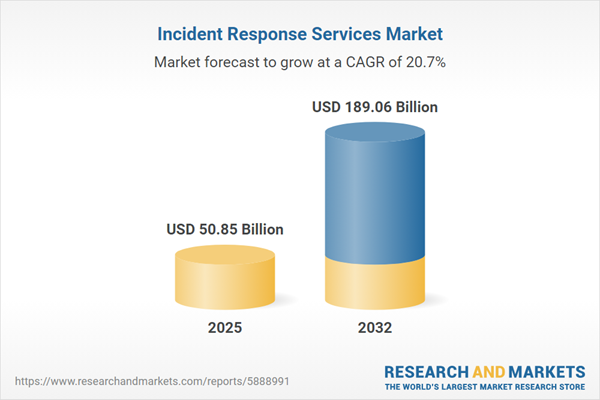Speak directly to the analyst to clarify any post sales queries you may have.
The incident response services market empowers senior leaders to strengthen cyber resilience, streamline regulatory compliance, and ensure business continuity through strategic risk management. Secure, adaptive solutions play a key role in maintaining organizational preparedness and supporting ongoing digital transformation.
Market Snapshot: Incident Response Services Market
The incident response services market is experiencing consistent growth, propelled by increased dependence on digital solutions and a heightened landscape of cybersecurity threats. Organizations across financial, healthcare, technology, and government sectors are significantly increasing their utilization of incident response services to improve compliance and protect daily operations. As digitization advances, organizations prioritize agile response strategies and uninterrupted workflows. These market dynamics demand sophisticated and adaptable incident response solutions that form a critical aspect of long-term planning across global industries.
Scope & Segmentation of the Incident Response Services Market
This section addresses essential opportunities for decision-makers to align resources and investments. The following key segments illustrate the variety and strategic depth of the market:
- Service Types: Consulting strengthens crisis preparation and strategic awareness; threat analysis, digital forensics, and penetration testing deliver rapid detection and investigation; continuous monitoring and managed threat hunting bolster prompt incident containment; platform management supports proactive risk control in response to novel threats.
- End User Industries: Banking, financial services, government, defense, manufacturing, retail, healthcare, IT, and telecommunications each require tailored approaches to meet specific compliance standards and mitigate unique operational and regulatory risks.
- Deployment Modes: Hybrid, private, and public cloud platforms, alongside on-premise and legacy systems, enable organizations to select deployment models that best fit their security, regulatory, and scalability considerations.
- Organization Sizes: Solutions are scalable, from small and medium-sized enterprises to large corporations, allowing alignment with a wide range of risk profiles and resource capacities.
- Regional Coverage: The Americas, Europe, Middle East, Africa, and Asia-Pacific regions reveal diverse regulatory requirements and threat environments, influencing strategies for service delivery and adoption.
- Key Market Players: Providers such as International Business Machines Corporation, Accenture plc, Deloitte Touche Tohmatsu Limited, Mandiant, PricewaterhouseCoopers International Limited, KPMG International Cooperative, Ernst & Young Global Limited, CrowdStrike Holdings, Cisco Systems, and Secureworks Corp drive best practices and partnership evaluations.
Key Takeaways: Strategic Insights
- Integrating incident response frameworks enhances organizational visibility and enables quick adaptation to changing cyber risks, supporting governance and sustaining operational resilience.
- Highly regulated sectors like finance and healthcare rely on digital forensics and comprehensive response protocols to protect sensitive data and adhere to compliance standards.
- Advanced technologies including AI and machine learning are transforming incident response. Automation accelerates detection and investigation, allowing security teams to focus on strategic initiatives as IT ecosystems expand.
- Partnerships with regional and local experts help enterprises address evolving data governance and regulatory needs, contributing to increased organizational confidence.
- Flexible, modular service models support rapid alignment with new compliance mandates, aiding in the maintenance of secure, ongoing business operations as threat landscapes evolve.
- Simulation-based incident scenarios facilitate continuous improvement, promoting proactive security cultures across all organizational levels and departments.
Tariff Impact: Managing Service Continuity amid US Import Duties
Recent increases in US tariffs affecting technology and cybersecurity components are impacting operational costs for incident response providers. In response, organizations are prioritizing investments in domestic and hybrid cloud infrastructure, as well as developing new alliances with local service vendors. These approaches help address regulatory demands, manage costs, and safeguard service continuity during periods of policy and economic shifts.
Methodology & Data Sources
The insights in this report are based on direct interviews with industry leaders, comprehensive academic research, and systematic tracking of global regulatory changes. This rigorous methodology ensures that the findings remain accurate and relevant to executive-level decision-making.
Why This Report Matters
- Empowers senior executives to objectively evaluate and improve incident response strategies for changing cyber threats and regulations.
- Guides procurement and investment in innovative threat management, supporting operational resilience and strategic growth.
- Offers actionable insights for compliance and security teams that must adapt incident response programs as industry requirements evolve.
Conclusion
This report provides senior leaders with strategic insights to enhance organizational readiness, promote uninterrupted operations, and proactively address emerging challenges in the cybersecurity landscape.
Additional Product Information:
- Purchase of this report includes 1 year online access with quarterly updates.
- This report can be updated on request. Please contact our Customer Experience team using the Ask a Question widget on our website.
Table of Contents
3. Executive Summary
4. Market Overview
7. Cumulative Impact of Artificial Intelligence 2025
Companies Mentioned
The companies profiled in this Incident Response Services market report include:- International Business Machines Corporation
- Accenture plc
- Deloitte Touche Tohmatsu Limited
- Mandiant, Inc.
- PricewaterhouseCoopers International Limited
- KPMG International Cooperative
- Ernst & Young Global Limited
- CrowdStrike Holdings, Inc.
- Cisco Systems, Inc.
- Secureworks Corp
Table Information
| Report Attribute | Details |
|---|---|
| No. of Pages | 188 |
| Published | October 2025 |
| Forecast Period | 2025 - 2032 |
| Estimated Market Value ( USD | $ 50.85 Billion |
| Forecasted Market Value ( USD | $ 189.06 Billion |
| Compound Annual Growth Rate | 20.6% |
| Regions Covered | Global |
| No. of Companies Mentioned | 11 |









